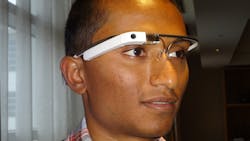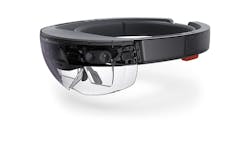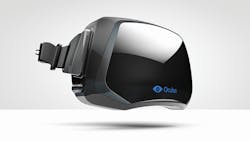What’s the Difference Between Augmented and Virtual Reality?
What’s the difference between augmented reality (AR) and virtual reality (VR) technologies? Actually the answer is relatively simple.
AR lets you see the outside world while adding to what you see while VR masks the outside world presenting its own version exclusively. Both provide a useful environment targeting different applications. For example, AR could be used to provide visual directions while the viewer is seeing their surroundings while VR is often used for gaming where an immersive virtual world can be presented without distractions from the real world environment.
Google Glass (Fig. 1) was not the first set of AR glasses, but it has been one of the more notable (see “A View Of Google Glass” on electronicdesign.com). It provides 640- by 360-pixel display for only a single eye. This allows a flat display to be presented that easily shows text and graphics. Google Glass is designed to operate with a Bluetooth-connected smartphone, although it can perform some functions independently.
Microsoft HoloLens (Fig. 2) can present 720p video to both eyes allowing 3D projections, not the 2D of Google Glass. These glasses also use a transparent screen so the user can see the outside world when nothing is being displayed. Images can be displayed with varying levels of transparency.
The HoloLens has more demanding display requirements than the 2D Google Glass because of the higher resolution and the fact that it provides a display to both eyes. This overhead can be reduced if the same 2D display is presented to both eyes.
Facebook’s Oculus Rift (Fig. 3) is a typical example of a VR headset. It completely blocks out the surrounding visual environment, presenting a virtual world using two 1080p displays, one for each eye. The default condition is an entirely black environment, unlike the HoloLens whose default condition is a view of the outside world.
One of the primary applications for VR glasses is 3D VR gaming. This works well since gaming environments are typically virtual worlds already. The difference is that VR glasses can provide a more immersive environment compared to a 2D or 3D panel display.
AR and VR glasses and system designs have their own challenges. Optics are required by both, but AR optics tend to be more complex because they must merge the viewing of the outside world with the virtual content.
One requirement for most AR and VR applications like 3D gaming is accurate head tracking. This means that the system will track the movement of the user’s head so the image presented will be oriented properly with respect to the virtual world. Turning your head to the right will reveal the virtual world to the right.
Head tracking is useful for AR as well. It can also be combined with information about the outside world so overlays could be rooted in or tracked based on those objects. For example, one AR application is to present information about a physical object that is being viewed through the glasses, such as a motor. The visual overlay might be a cutout view of the motor or additional information about the motor. The presented material would be changed depending upon the user’s viewpoint, allowing them to move around the motor to see different information.
Accuracy and latency are two issues associated with head tracking. Inaccurate tracking or high latency can cause problems for the user, often making the experience painful. Accurate tracking and low latency provide a more realistic and enjoyable experience. There are a variety of techniques that can be used for head tracking. Note, the latency of the head tracking is only one part of the equation since there is latency due to the creation and display of an image based on the head-tracking results.
One aspect often overlooked when discussing AR and VR topics is audio feedback. Sound is directional and there are often multiple sources within an application or virtual environment. Accuracy and latency issues arise with sound, but they tend to be less of an issue than with regard to visual feedback.
Creation of content for AR and VR differs depending upon the application. VR gaming normally creates the environment programmatically. It is possible to simply record a 3D environment using a 360-deg. camera like the Vuze VR camera (Fig. 4). This could be done for a real-estate or tour application that presents buyers with the virtual view of a house or office. The cameras could be used to record an existing environment.
The difference between AR and VR is pretty straightforward. One merges with the outside world while the other presents a totally virtual environment. There are many applications like gaming that can utilize AR and VR technology while others will use one or the other.
About the Author
William G. Wong
Senior Content Director - Electronic Design and Microwaves & RF
I am Editor of Electronic Design focusing on embedded, software, and systems. As Senior Content Director, I also manage Microwaves & RF and I work with a great team of editors to provide engineers, programmers, developers and technical managers with interesting and useful articles and videos on a regular basis. Check out our free newsletters to see the latest content.
You can send press releases for new products for possible coverage on the website. I am also interested in receiving contributed articles for publishing on our website. Use our template and send to me along with a signed release form.
Check out my blog, AltEmbedded on Electronic Design, as well as his latest articles on this site that are listed below.
You can visit my social media via these links:
- AltEmbedded on Electronic Design
- Bill Wong on Facebook
- @AltEmbedded on Twitter
- Bill Wong on LinkedIn
I earned a Bachelor of Electrical Engineering at the Georgia Institute of Technology and a Masters in Computer Science from Rutgers University. I still do a bit of programming using everything from C and C++ to Rust and Ada/SPARK. I do a bit of PHP programming for Drupal websites. I have posted a few Drupal modules.
I still get a hand on software and electronic hardware. Some of this can be found on our Kit Close-Up video series. You can also see me on many of our TechXchange Talk videos. I am interested in a range of projects from robotics to artificial intelligence.





